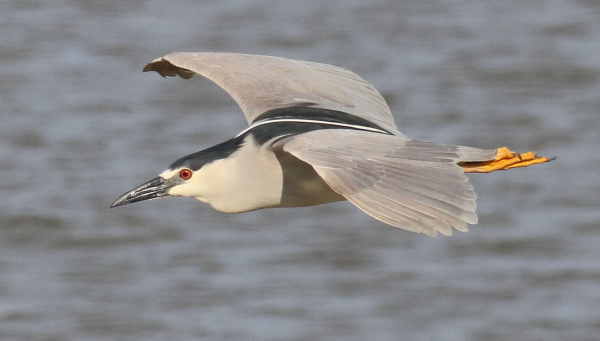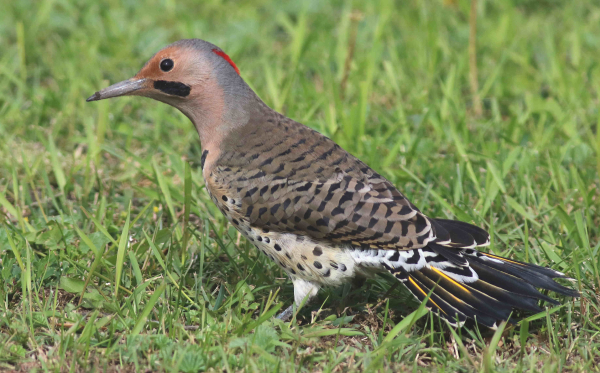
A Black-crowned Night Heron inspired Paul Kerlinger’s interest in birding.

A Northern Flicker inspired the “father of modern birding,” Roger Tory Peterson, to lead a life inspired by birds.
|
One beautiful May day in the Cape May area I shared a memorable lunch with a fun group of birders during a break in a field trip in southern New Jersey. Our leader, Paul Kerlinger, the Director of the Cape May Bird Observatory at the time said he would like to pose a question to each of us: “What bird inspired you to become a birder?” It’s an interesting question that provided an enjoyable response by each of the birders sitting around the big picnic table.
Paul started the discussion with his “bird of inspiration,” a Black-crowned Night Heron that he encountered while fishing for Striped Bass, although he had a more expansive description than my simple recollection. Each person at the table shared their special bird and the story behind it. All had become birders as adults or while in college. When it came to me, I had to explain that while I have many favorite birds, in retrospect, I have always been a birder and had no real “beginning.” I joked that I was either born a birder or my interest was a continuation from a past life incarnation.
My first birding memories are from being in our backyard in Bismarck in early spring, I must have been three. I accompanied my Mom outdoors on a sunny but cool windy April morning, and as she hung wash on the clothesline to dry, my attention was drown to flocks of Canada Geese migrating north along the Missouri River Valley. After the first few flocks passed overhead, I heard another call – certainly not the call of any goose. Then I saw a circling flock high overhead to the west – Sandhill Cranes! Does that count? Those were the first birds I can remember, but I’m sure my Mom and Dad pointed out spring robins from our windows when I was much younger.
My initial interest in birds was really all about working toward being a wildlife biologist – an ornithologist – even as a child. Beginning at that very early age, I noticed every bird, identified it, and studied it as long as I could. I read and pretty much memorized my field guide, and by the time I was 9 years old, I began censusing all the birds I would see when my family drove the two hours from Bismarck to my grandparents’ and cousin’s homes in southcentral North Dakota – near where I live now. I would keep a list of all the species I would see, along with a tally of all the individuals of each species I saw – not unlike the lists I keep on special birding trips today.
When I grew up in in the capitol city of Bismarck, I wasn’t aware of any birders. I knew about wildlife biologists who specialized in birds and worked at the U.S. Fish and Wildlife Service office, and at the office of the North Dakota Game and Fish Department, but until I was about 13 years old, when I interacted with a medical doctor who was an enthusiastic birder I was the one of a kind – kind of. The doctor was very helpful, although I think I only met with him once or twice because he was in charge of approving my bird study merit badge as I worked toward the rank of Eagle Scout.
Then, of course, when I began my university studies one thing quickly led to another when I met my primary ornithology professor, Dr. James Grier, who I still share a friendship with today. Then, everyone with an interest in birds outside of school was still a wildlife biologist or ornithologist rather than a birder. This may have been a matter of the geography of where I lived, although I also spent a couple college summers in Wisconsin and Colorado, but I think birding just had not caught on by then – certainly not by the tens of millions that we birders constitute today!
We obviously went birding during ornithology class, under the direction of Dr. J. Frank Cassel, and we kept lists and counts of birds – just as I had when I was 9 and 10 and ever after. Incidentally, I was lucky enough to study under Jim and Frank, both of whom had received their doctorates at Cornell University, each studying under a different generation of professors ranging from the famous Arthur Allen to the no less famous Tom Cade and William Dilger. I likewise worked for years under the guidance of Dr. George Archibald and Dr. David Gilmer, esteemed ornithologists with the International Crane Foundation and Northern Prairie Wildlife Research Center respectively. All of us, and our many compatriots, were ornithologists – not really birders; yet all of us were birders!
In retrospect, I guess I’m a true hybrid – a birder and a biologist. There’s a fine line between the two. For me, it’s a simple combination that can’t be divided. I guess I diverged off-subject a bit, while adding a bit of background information and providing an example of how one person became very committed to birding, ornithology, and bird conservation.
Back on subject: Even Roger Tory Peterson had his “bird of inspiration.” The father of modern birding often recounted his initial contact with a Northern Flicker as a boy. Roger truly believed his close encounter with the flicker inspired his focus in life – certainly a lucky thing for every birder since then. It’s amazing to see how an interaction with a given bird can change someone’s life and life direction, or just improve the quality of life for birders one by one. What bird inspired you to become a birder?
Article and photographs by Paul Konrad
Share your birding experiences anytime at editors2tbw@gmail.com